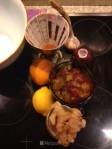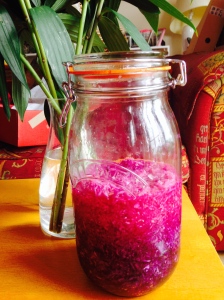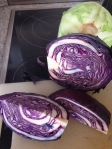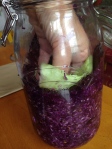My delicate digestion is crazy for probiotics for their soothing and restorative effect. Probiotics? They are good bacteria which stop bad bacteria giving your gut a hard time (bloating etc).
Probiotics are not some new-fangled idea – every traditional society has its fermented ‘good bacteria’ food, such as sauerkraut.
Annie Levy (and the Guardian sustainable blog of the week) sent me a jar of her homemade (fermented) plum kimchi.
I have never tasted anything as wildly spicy and salty, gut-zingy and healing .
I had it as an accompaniment to Co-exist Community Kitchen tenants’ (£2.50) vegetarian lunch (see pic).
Then I got home and ate the rest of the jar (it goes with everything savoury).
Please see Annie Levy’s recipe for Plum Kimchi at her blog, Kitchen Counter Culture (great name for a radical blog).
Here’s how I made the crazy condiment.
Assemble in a large bowl:
All the cloves in a head of garlic (grown by Nadia Hillman)
Grated raw ginger (large thumb – or more)
2 raw red onions sliced
1 lemon chopped
1 large orange chopped
half of 1/4 American cup hot pepper powder
1/4 American cup of (sea) salt
Add to 1 pint of raw uncooked plums (slice with sharp knife to remove stones). Use organic wherever possible because organic is different – fewer chemicals and more goodness.
Place a plate to press down the raw veg/fruit mix and leave it for two days at room temperature before spooning into jars. The salt draws out the water in the raw veg/fruit, thus pickled in its own salty water.
The first pic shows the cast assembled, the second is the cast cut-up and mixed with spice and salt. Note: creative chaos. Why eat boring same-old packet food when you can go mad in the kitchen?!
Three announcements.
1. Check out Annie Levy’s food fermentation workshops. “A true kitchen witch, Annie’s food fermentation workshop is an informative & exciting, deliciously interactive learning experience and exploration of food alchemy.”
2. Bristol is hosting a probiotic event on Saturday 15 November 2014 at 3 – 6 pm.
The power of probiotics foods for digestive and immune healing – rebuild your gut heal your life. Fermentation Fetish with Holly Paige and Kenny Bountiful Sun Tickets (£15) – book here.
3. And finally for everyone who loves real food including fermentation – please check out and pledge for the publication of Living Food – A feast for soil and soul, from soil sister, Daphne Lambert.







